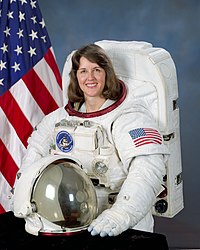Kathryn C. Thornton
| Kathryn Thornton | |
|---|---|

|
|
| Country: | United States |
| Organization: | NASA |
| selected on | May 23, 1984 ( 10th NASA Group ) |
| Calls: | 4 space flights |
| Start of the first space flight: |
November 23, 1989 |
| Landing of the last space flight: |
November 5, 1995 |
| Time in space: | 40 d, 15 h, 14 min |
| EVA inserts: | 3 |
| EVA total duration: | 21h 11min |
| retired on | August 1, 1996 |
| Space flights | |
Kathryn Ryan Cordell Thornton (born August 17, 1952 in Montgomery , Alabama ) is a former American astronaut .
education
Thornton received a bachelor's degree in physics from Auburn University in 1974 and a master's degree in physics from the University of Virginia in 1977 . In 1979 she received a PhD in physics from the University of Virginia.
In 1979 Thornton received a NATO scholarship to continue her research at the Max Planck Institute for Nuclear Physics in Heidelberg . In 1980 she returned to the USA and became a physicist at the US Army Foreign Science and Technology Center.
Astronaut activity
In May 1984, Thornton was selected by NASA as an astronaut aspirant.
STS-33
On November 22, 1989, Thornton launched into space for the first time as a mission specialist on the space shuttle Discovery . A Defense Ministry satellite was suspended during the flight . After 79 orbits , the Discovery returned to Edwards Air Force Base on November 27th .
STS-49
On May 7, 1992, Thorton flew into space for the second time as a mission specialist on the maiden flight of the space shuttle Endeavor . The aim of this mission was to salvage the Intelsat VI-F3 communications satellite , which had been launched two years earlier, for repair. It was not until the third external mission (EVA) that the satellite could finally be captured by hand. As a result, Intelsat received a new apogee motor so that it could enter a designated geostationary orbit . Structures and tools were tested at another EVA.
STS-61
Thornton flew into space for the third time on December 2, 1993 as a mission specialist on the space shuttle Endeavor . It was the Hubble Space Telescope's (HST) first repair mission . The main mirror of the observatory, which had started three and a half years earlier, was faulty, which led to blurred images. Thornton participated in two of the five extravehicular activities in part (EVAs) that were required to install the correction instrument COSTAR and the WF / PC-II camera. In addition, the solar panels used to power the HST were replaced.
STS-73
On October 20, 1995, Thornton launched into space as a mission specialist on the Columbia space shuttle . On this 16-day Spacelab mission called “United States Microgravity Laboratory (USML) 2”, 16 main experiments in the research disciplines of materials, combustion, fluid physics and biotechnology were carried out.
According to NASA
On August 1, 1996, Thornton left NASA and became a professor of physics at the University of Virginia. She is also the director of the Center for Science, Mathematics and Engineering Education there.
Private
Kathryn Thornton is married and has five children, two of whom are stepons.
See also
Web links
- Short biography of Kathryn C. Thornton at spacefacts.de
- NASA biography of Kathryn C. Thornton (English; PDF)
- Biography of Kathryn C. Thornton in the Encyclopedia Astronautica (English)
| personal data | |
|---|---|
| SURNAME | Thornton, Kathryn C. |
| ALTERNATIVE NAMES | Thornton, Kathryn Ryan Cordell (full name) |
| BRIEF DESCRIPTION | American astronaut, college professor in Virginia |
| DATE OF BIRTH | 17th August 1952 |
| PLACE OF BIRTH | Montgomery , Alabama, USA |

